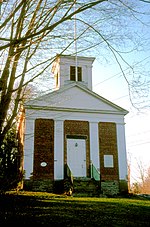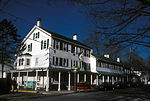Essex Historic District

Essex Historic District was a proposed district, nominated for listing on the National Register of Historic Places in 1978. It would have included parts of Main, N. Main, S. Main, and W. Main Sts., in Essex, Connecticut.The NRIS database recorded, on June 21, 1978, with reference number 78003525, that the district received listing status of DR, which means "Date Received/Pending Nomination". There apparently was no further National Register action, and the district was not listed.Multiple internet webpages assert that Essex Historic District exists and/or was listed on the National Register, but those webpages appear to be incorrect. They apparently reflect incorrect interpretation of the National Register's NRIS database.
Excerpt from the Wikipedia article Essex Historic District (License: CC BY-SA 3.0, Authors, Images).Essex Historic District
Main Street,
Geographical coordinates (GPS) Address Nearby Places Show on map
Geographical coordinates (GPS)
| Latitude | Longitude |
|---|---|
| N 41.353 ° | E -72.391 ° |
Address
Main Street 2-4
06426
Connecticut, United States
Open on Google Maps








